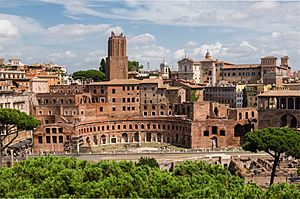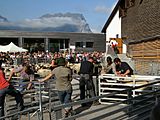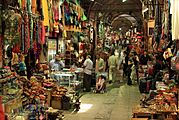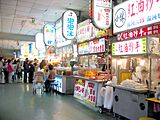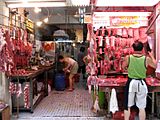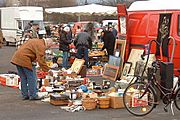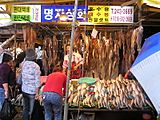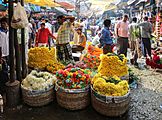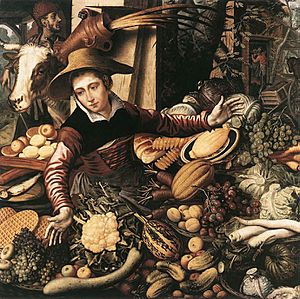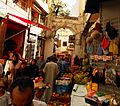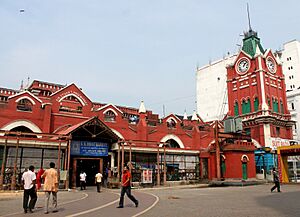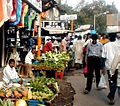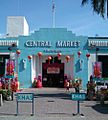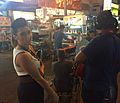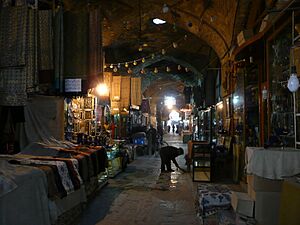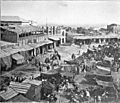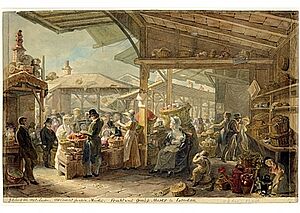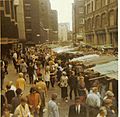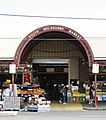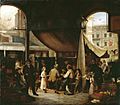Marketplace facts for kids
A market or marketplace is a special place where people meet regularly to buy and sell things. These things can be food, animals, or other goods. Depending on where you are in the world, a market might be called a souk (in Arabic countries), a bazaar (in Persian countries), a mercado (in Spanish-speaking places), or a tianguis (in Mexico).
Some markets are open every day and are called permanent markets. Others happen only once a week, or on special days like festivals, and these are called periodic markets. The way a market looks depends on the people, their culture, and the weather where it is. Markets can be outdoors, like a market square, or indoors, like a market hall or food hall.
Markets have been around for a very long time, as long as people have been trading. The first bazaars likely started in Persia. From there, they spread to the Middle East and Europe. Old records show that cities started to set aside special areas for trading around 3,000 BCE. This helped bazaars grow. In the Middle East, bazaars often had covered roofs to protect shoppers and sellers from the hot sun. In Europe, informal markets slowly became more organized from the 12th century. During the Middle Ages, rules about weights and measures made people trust markets more. This meant they felt confident about the quality of goods and fair prices.
Shopping at a local market is a normal part of daily life in many countries. Because markets help make sure people have enough food, governments often regulate them. Many marketplaces are now considered historic sites. They are important parts of a town's culture and are often popular places for tourists to visit.
Contents
- What does 'market' mean?
- How Markets Started and Grew
- Different Kinds of Markets
- Markets in Art and Books
- Markets Around the World
- Images for kids
- See also
What does 'market' mean?
The word market comes from the Latin word mercatus, which means "market place." The first time the word market was written in English was in the Anglo-Saxon Chronicle in 963 AD. This book was made during the time of Alfred the Great. The old phrase was “Ic wille þæt markete beo in þe selue tun,” which means “I want to be at that market in the good town.”
How Markets Started and Grew
Markets have existed since ancient times. Some historians think markets started when humans first began to trade. Open-air markets were common in ancient Babylonia, Assyria, Greece, and Egypt. However, not all societies had markets. The Greek historian Herodotus noticed that markets did not develop in ancient Persia.
Markets in Ancient Times
Across the Mediterranean Sea, many markets appeared during the early Bronze Age. People traded all sorts of goods, like salt, dyes, cloth, metals, and tools. Archeologists have found that traders in the Bronze Age used different routes for different areas. Both goods and new ideas traveled along these trade routes.
In the Middle East, a type of bazaar first appeared around 3,000 BCE. Early bazaars were long rows of alleys with stalls on both sides. They often stretched from one city gate to another. For example, the bazaar at Tabriz is about 1.5 kilometers long and is the longest covered bazaar in the world. Herodotus also wrote that in ancient Egypt, women often went to the market and traded, while men stayed home and wove cloth.
In ancient Greece, market places called agorai were in most cities. These were open spaces where people gathered. Between 550 and 350 BCE, Greek sellers grouped together by what they sold. Fish sellers were in one area, clothing in another, and expensive goods like perfumes were in a separate building. Greek cities had special zones for trade, often near the city center. These were called stoa, which were covered walkways. Government officials in Athens checked weights, measures, and money to make sure people weren't cheated.
In ancient Rome, trading happened in the forum. Rome had two main forums: the Roman Forum and Trajan's Forum. Trajan's Market, built around 100-110 CE, was a huge area with many buildings and shops on four levels. The Roman forum might have been the first place with permanent shops. In ancient times, people often traded directly or used bartering systems. Local farmers sold small amounts of extra produce, and artisans sold things like leather goods and pottery. Wealthy landowners often managed their own trade, even importing and exporting goods.
At Pompeii, there were many markets for its 12,000 people. Food markets were near the Forum, while animal markets were on the edge of the city. A building near the Forum was likely a grain market. The macellum was probably a meat and fish market. Market sellers paid a tax to trade on market days. Old writings show that markets were very important for community life and trade. They were also important places for people to meet and socialize.
Markets in Medieval Europe
In early Western Europe, markets grew near monasteries, castles, or royal homes. These places needed many goods and services, both fancy and everyday items. They also offered some safety to merchants. These trading centers attracted sellers, which helped towns grow. The Domesday Book from 1086 lists 50 markets in England, but many historians think there were actually more. Between 1200 and 1349, about 2,000 new markets were started in England.
From the 12th century, English kings gave special permission, called a charter, to local lords to create markets and fairs. A charter protected the town's trading rights in exchange for a yearly fee. Once a chartered market was set for certain days, no nearby rival market could open on those same days. Fairs, usually held once a year and linked to religious festivals, sold expensive goods. Regular weekly markets mainly sold fresh food and daily necessities. Fairs also often had entertainment like music or games. As more markets appeared, towns set them far enough apart to avoid too much competition, but close enough for local farmers to make a round trip in one day (about 10 km). Some outdoor markets in Britain have been open continuously since the 12th century.
In Italy, markets with movable stalls under covered arches became popular. Examples include the Loggia del Mercato Nuovo (1547) and Mercato Vecchio in Florence. Historians Braudel and Reynold studied European market towns from the 13th to 15th centuries. They found that regional markets were held once or twice a week, while larger cities had daily markets. Over time, permanent shops started opening every day and slowly replaced the periodic markets. Traveling sellers, called peddlers, continued to fill in any gaps in distribution.
During the Middle Ages, markets were places for quick buying and selling. Shops had higher costs but could offer regular hours and build relationships with customers, sometimes even offering credit. Most trade was local, with goods traveling short distances.
Beach markets in northern Europe, during the Viking period, mainly sold fish. From the 11th century, more imported goods were sold at beach markets, giving people access to exotic and luxury items. Markets became more international. After the European age of discovery, goods came from far away, like cloth from India, porcelain from China, spices from Asia, and tobacco and coffee from the New World.
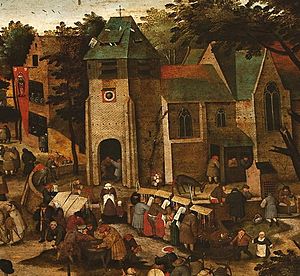
People in medieval England were quite careful about what they bought. They thought about the variety, quality, and price of goods when deciding where to shop. As more market charters were given, competition between towns grew. Towns tried to build a good reputation for quality produce and good facilities for visitors, like covered areas. By the 13th century, areas known for textiles built special halls to sell cloth. Blackwell Hall in London became a cloth center. Towns like Bristol and Stroud became known for specific types of cloth.
In markets, goods usually don't have brands, so buyers can't easily check quality before buying. Because of this, checking weights, measures, food quality, and prices was very important. In medieval times, rules for these things first appeared locally. The Charter of Worcester (884-901 AD) had fines for dishonest trading. These local rules were written down in 15th-century England in the Statute of Winchester. This document set rules for 16 different trades, mostly linked to markets, covering fraud, prices, quality, and measures. These rules helped markets gain buyers' trust.
A writer named John Leland in the 16th century described some markets as "celebrate" or "very good," and others as "poor" or "mean." Over time, some products became linked to certain places. This gave customers helpful information about the type and quality of goods and where they came from. This was an early form of product branding.
Markets in the Middle East and Mesoamerica
In the Middle East, before the 10th century, markets were usually outside the city. Along trade routes, markets were often near a caravanserai, which was a place for travelers to rest. Later, markets became part of the city and were covered to protect traders from the weather. Markets in Mecca and Medina were important trade centers in the 3rd century CE. The Grand Bazaar in Istanbul is one of the oldest continuously operating markets. Its construction started in 1455.
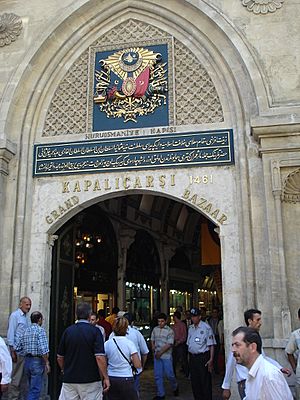
In Mesoamerica (like ancient Mexico), a system of traders grew on its own. Trade networks existed hundreds of years before the Aztec empire. Local markets for daily needs were called tianguis. A pochteca was a professional merchant who traveled long distances to get rare or luxury goods for nobles. The Spanish conquerors were very impressed by the local markets in the 15th century. The Mexica (Aztec) market of Tlatelolco was the largest in all the Americas, even bigger than markets in Europe.
Different Kinds of Markets
There are many ways to sort markets. One way is by who buys things and where the market fits in the selling process. This gives us two main types: retail markets (where you buy things for yourself) and wholesale markets (where businesses buy large amounts of goods).
Another way to classify markets is by how long goods can be kept.
- Very short period markets sell things that spoil quickly, like fruit, vegetables, meat, and fish. These must be sold in a few days.
- Short period markets sell non-perishable goods. Here, the amount of goods can be increased by adding more workers.
- Long-period markets are where the amount of goods can be increased by investing in new buildings or equipment.
Markets can also be sorted by their size (local, national, or international), their physical setup, or what they sell.
Here are some common types of physical markets:
- Bazaar: Often a covered market in the Middle East.
- Car boot sale: People sell household items from their car boots, popular in the UK.
- Indoor market: Any market inside a building.
- Marketplace: An open area in a town where a market is or was held.
- Market square: An open area in a European town center with stalls.
- Public market: In the US, an indoor market building selling various goods.
- Street market: A public street with stalls on one or both sides.
- Floating markets: Goods are sold from boats, common in Thailand, Indonesia, and Vietnam.
- Night markets: Popular in Asia, open at night, often with street food and a relaxed shopping feel.
- Wet markets: In Asia, traditionally sold live animals and fresh produce.
Markets can also specialize in certain goods:
- Animal markets (livestock markets)
- Antique markets
- Farmers' markets: Focus on fresh produce and gourmet foods made from farm products.
- Fish markets
- Flea markets or swap meets: People rent space to sell or trade used goods, cheap items, or good quality items at low prices.
- Flower markets
- Food halls: Offer gourmet food to eat there or take away.
- Grey market: Sells second-hand or recycled goods.
- Handicraft markets
- Supermarkets
-
Marketplace: Main Market Square, Kraków, Poland: Europe's largest medieval town square
-
Floating market: Damnoen Saduak floating market in Ratchaburi, Thailand, is a famous tourist attraction.
-
Night market: Shilin Night Market, Taiwan
-
Wet market in Hong Kong
-
Wet market in Singapore
-
Mallick Ghat Flower Market, Kolkata, India
Markets in Art and Books
Markets have often been shown in paintings, especially by Dutch artists in the 16th century. Pieter Aertsen was known as the "great painter of the market." He and his nephew, Joachim Beuckelaer, painted many market scenes and street vendors. Artists were interested in markets because the way markets worked was changing. People started to see two types of merchants: local sellers like bakers and grocers, and a new group of traders who dealt with goods or money on a much larger scale.
In the 17th and 18th centuries, as Europeans explored North Africa and the Middle East, artists visited these places and painted scenes of daily life. Europeans often saw these "Oriental" places as exotic and mysterious. This led to a style of painting called Orientalism. Artists focused on the beauty of the land, including markets and bazaars, and the interesting architecture of covered market places.
Individual markets have also appeared in books. Les Halles, a huge market in central Paris, was called the "Belly of Paris" by author Émile Zola in his novel Le Ventre de Paris. Les Halles was featured a lot in both books and paintings.
Markets Around the World
Markets in Africa
Markets have been in parts of Africa for centuries. An 18th-century writer described markets in West Africa. He noted how well-organized they were, with a judge and officers to prevent cheating. These markets sold all kinds of goods, from food and animals to cloth and hardware. He also mentioned unique foods like roasted monkeys and dried bats sold in markets in the Republic of Benin.
Ethiopia
Ethiopia produces and exports a lot of grains. Many wholesale markets help distribute these products. Important wholesale markets include Nekempte and Addis Ababa. Some major retail markets are Addis Mercato in Addis Ababa, which is the largest open-air market in the country, and Awasa Lake Fish Market.
Ghana
Ghanaian markets have continued to exist even after attempts to remove them. In the late 1970s, the government blamed market traders for food shortages and high prices. In 1979, the Makola market was destroyed, but traders were back selling goods within a week.
-
Kumasi Market in Ghana
Morocco
In Morocco, markets are called souks. They are usually found in a city's Medina (old city). Shopping at a produce market is a normal part of daily life. In larger cities, Medinas are often a collection of souks in narrow streets. Different sections are known for specific goods, like silver or textiles. In Tangier, a large market fills the Medina streets, divided into the Grand Socco and Petit Socco. These markets sell fresh food, cooking tools, pottery, rugs, clothes, and more. The Medina at Fez is the oldest, founded in the 9th century, and is a World Heritage site. It's known for its narrow lanes where no cars are allowed. In Marrakesh, the main markets are in the Medina, and a colorful market is held daily in the Jemaa el-Fnaa square.
The Gambia
The "Gambia is Good" project started in 2004 to encourage buying local fresh produce instead of imported goods. Many goods are sold informally on street corners. However, larger towns have dedicated open-air and covered markets. Notable markets include the Serekunda Market, which sells produce, animals, clothes, and crafts. The Albert Market in Banjul sells fresh produce and local fabrics. Other interesting markets are the Bakau Fish Market and the Woodcarvers Market in Brikama.
-
Serekunda Market, Serekunda, The Gambia
Markets in Asia
Markets in Asia are changing as supermarkets become more common. Many supermarkets buy directly from farmers, which changes the traditional role of markets. To survive, markets are now focusing on ready-to-eat food and take-away meals.
East Asia
China
In China, street and wet markets have existed for centuries. Many were restricted in the 1950s and 60s but were allowed to reopen in 1978. China has over 9,000 wholesale produce markets. Some are very large, like Beijing's Xinfadi Wholesale market. The Beijing Zoo Market is a retail market with about 20,000 stalls and 100,000 customers daily. China is a big importer and exporter of fruits and vegetables. Besides food markets, China has specialized markets for silk, clothing, and antiques. In big cities, people are starting to buy groceries online with home delivery.
Hong Kong
Hong Kong imports most of its fresh produce. Street markets are open every day except for a few Chinese holidays. Stalls need licenses from the government. Types of street markets include fresh foods, clothing, cooked foods, flowers, and electronics. Some traditional markets have been replaced by shopping centers or supermarkets. Others, like Tung Choi Street, have become tourist spots.
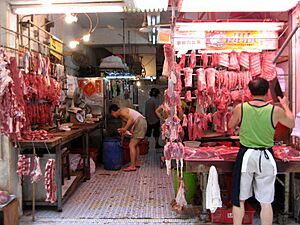
Japan
- Tsukiji fish market
- Kochi Sunday Market
South Korea
Most markets in South Korea are wholesale markets, but regular customers can still buy things there. The Gwangjang Market is the country's top market and a popular place for tourists.
Taiwan
Taiwan grows most of its own produce, so it has many active wholesale and retail markets. Taiwan is known for having "the best night market scene in the world" and exciting street food in Asia.
South Asia
In South Asia, especially Nepal, India, and Bangladesh, a Haat is a regular rural market, usually held once or twice a week.
India
Historians believe Indian marketplaces first appeared during the Chola Dynasty (around 850-1279 CE). There were different types of markets: nagaaram (streets of shops), angadi (markets), and perangadi (large markets in inner city areas). Covered markets, called suqs, may have come from the Middle East around the 10th century. They were found along the Silk Road. India also had temporary seasonal markets. In the 16th century, covered bazaars became part of city centers. Markets were well known during the colonial era. Some specialized in certain goods, like fine cloth in Patna.
Today in India, there are many types of markets:
- Wholesale markets: Primary (local villages), Secondary (smaller merchants), and Terminal (sell directly to end-users).
- Retail markets: Found in villages, towns, and cities.
- Fairs: Held on religious days, selling animals and farm produce.
A landa bazaar is a market with very low prices where only second-hand goods are sold. A saddar is the main market in a town, and a mandi is a large marketplace. A Meena Bazaar sells goods to raise money for charity.
-
Magh Mela at Prayaga Sangam Uttar Pradesh India is a fair associated with the Sankranti Hindu festival
-
Goan sausages being sold at the Mapusa market, Goa, India
Southeast Asia
Southeast Asia is famous for its night markets, floating markets, and "pirate markets" (selling fake designer goods). Many Asian countries have unique market systems. A wet market sells fresh fruit, vegetables, fish, seafood, and meat. Morning markets sell fresh produce, while night markets sell non-perishable items like clothing, souvenirs, and personal goods.
Indonesia
In Indonesia, a Pasar pagi is a "morning market" that operates from early morning to afternoon, selling mostly fresh produce. A Pasar malam is a night market, open from late afternoon to night, usually on specific days. Pasar malam is for relaxed shopping and eating, selling ready-to-eat food, snacks, clothes, and trinkets. Major textile markets are Tanah Abang in Jakarta and Pasar Baru in Bandung. Notable batik markets are Pasar Klewer in Solo and Pasar Beringharjo in Yogyakarta.
-
Pasar Gede central market, Solo
-
Pasar Keputran, a pasar pagi or morning wet market, Surabaya
-
Flower market, Bali
-
Siring floating market, Banjarmasin
Malaysia
In Malaysia, Pasar malam refers to a night market, and Pasar pagi is a morning wet market. Some jungle produce markets sell native fruits and vegetables. The main markets in Kuala Lumpur include Pudu market, Central Market, Kuala Lumpur, and Chow Kit Wet Market.
Philippines
In the Philippines, palengke means a group of stalls under a covered roof. Locals use palengkes for daily shopping. Public markets are the main trading centers in cities. Weekend markets are popular for organic and handmade foods. Farmers' markets have also become popular. The Cubao Farmers Market gained international attention after being featured on a TV show.
-
A Palengke, Danao City Philippines
Thailand
Bangkok's markets are popular with both locals and tourists. Bangkok has the world's largest weekend market, Chatuchak. Floating markets are found in Bangkok and other places. Sellers not only sell fresh produce from boats but also cook meals and snacks on their boats for customers. These floating markets are a popular tourist attraction.
West Asia
In West Asia, markets are known as bazaars or souks. The first bazaars are thought to have started in Persia. In ancient Iranian cities, there were three types of bazaars: periodic bazaars (held occasionally in open spaces), urban bazaars (covered public walkways with shops), and local bazaars (smaller versions in specific city districts). In pre-Islamic Arabia, markets were either permanent city markets or temporary seasonal markets.
Iran
Markets with historical or architectural importance include:
- Grand Bazaar, Tehran
- Bazaar of Kashan
- Bazaar of Isfahan - a historic site and the longest covered market in the world.
- Bazaar of Tabriz - a World Heritage Site that grew along the ancient silk routes.
- Vakil Bazaar in Shiraz.
Israel
The Hebrew word for market is shuk. Food markets are in every major city. Famous markets include the Carmel Market in Tel Aviv and Mahane Yehuda Market in Jerusalem.
Turkey
Street markets are called pazar in Turkish. They are usually named after the day of the week they are held, opening early and closing in the evening. Every district in Turkey has its own open market selling everything from fresh food to clothes and household items. Famous examples in Istanbul include the Wednesday Pazar of Fatih and the Friday Pazar of Ortaköy.
A market with permanent shops is called "çarşı." Famous examples are the Kapalıçarşı (Grand Bazaar) and Spice Bazaar in Istanbul.
Markets in Europe
East Europe
Hungary
- Central Market Hall, Budapest - built in 1897, the largest market in Budapest.
Romania
North Europe
Denmark
- Torvehallerne Market, Copenhagen - specializes in Nordic Foods.
Finland
- Market Square, Helsinki
- Market Square, Turku
Latvia
Riga Central Market
South Europe
Croatia
In Serbo-Croatian, a farmer's market is called tržnica, or informally pijaca, plac, or pazar.
- Dolac, Zagreb
Greece
Street markets in Greece are called laikes agores, meaning "people's market." They are very common, including in Athens. These weekly morning markets mostly sell fresh produce, fish, and flowers. Annual street markets, called panigyri, happen around churches on saint days. These are more festive, with attractions and food stalls, selling clothes, household items, and toys. Athens also has several covered markets.
- New Market (Nea Agora), Rhodes Island
- Central Municipal Market, Athens - a 19th-century market.
Italy
- Campo de' Fiori, Rome
- Mercato centrale di San Lorenzo, Florence
- Testaccio Market, Rome
Ancient and Historic Italian Markets
- Trajan's Market, Rome - ruins of an ancient market.
- Loggia de Mercato Nuovo, Florence, built between 1547 and 1551.
Serbia
In Serbo-Croatian, a farmer's market is called tržnica, or informally pijaca, plac, or pazar. Markets in big cities are open daily. In smaller towns, markets often open once a week on a specific day.
- Kalenić, Belgrade
- Great Market, Belgrade - built around 1854.
Slovakia
Spain
In Spain, there are two types of retail markets: permanent markets and periodic markets. Permanent markets are usually in a building with stalls. Periodic markets appear on streets and plazas on specific days, often selling handmade goods. Produce markets, farmers' markets, and flea markets are common. Street vendors are also common, selling goods laid out on mats.
Barcelona
The first records of markets in Barcelona are from the 10th century. Barcelona now has 39 produce markets. Every neighborhood has at least one fresh produce market. It's said that you are never more than a 10-minute walk from a market in Barcelona. Barcelona's markets get about 62 million visits yearly. Some large produce markets include La Boqueria, Mercat del Born, and Mercat de Santa Caterina. Barcelona also has many non-food markets, like the street market La Flor de Las Ramblas.
-
Fruit display at La Boqueria market in Las Ramblas Barcelona
Madrid
The main markets in central Madrid are San Anton Market, San Miguel Market (a gourmet food market), and El Rastro (the largest open-air flea market).
Valencia
The Mercado Central is the main public market in Valencia. Built around 1900, it mixes Gothic and Art Nouveau styles. It's popular for its fresh fish and seafood, which you can buy and then have cooked at nearby street stalls. The Mercado de Colón is also a very popular fresh produce market.
Seville
Popular markets in Seville include the Triana market and the Central market inside the Metropol Parasol complex. Seville also has smaller neighborhood markets like Mercado de la Calle Feria.
West Europe
Austria
- Naschmarkt, Vienna - a market from the 16th century.
Belgium
In the 16th century, Antwerp became the largest market town in Europe.
- Grote Markt (Antwerp)
France
Paris was one of the first European cities to have formal, centralized, and covered markets. Les Halles, a huge wholesale market, existed by the 13th century. It was torn down in 1971 to build an underground shopping area.
- Raspail Market, Paris
-
At the market stall, painting by Louise Moillon, 1609
Germany
- Christkindlesmarkt, Nuremberg (Christmas market)
- Markthalle IX, Berlin - built in 1891.
Netherlands
- Markthal Market, Rotterdam
- Vismarkt, Groningen
United Kingdom
Most retail markets in the UK are run by local governments. A few are run by private groups. Traders need licenses to sell in a specific spot. A voluntary scheme called The Market People helps make sure traders are trustworthy. It gives traders a MarketPASS if they show ID, insurance, and hygiene certificates. A study found that Britain has over 1,100 traditional retail markets and over 600 farmers' markets. Traditional outdoor street markets are still common but are becoming less popular. Markets are also a big draw for tourists. Some researchers divide markets into traditional markets and gentrified markets. Traditional markets sell large amounts of goods cheaply. Gentrified markets focus on special items like organic foods, local produce, handmade goods, or vintage clothing. While traditional markets are declining, gentrified markets are growing.
England's Chartered Markets
From the 11th century, English kings gave special permission, called a charter, to local lords to create markets. This charter gave lords the right to collect fees from sellers and protected the town from other nearby markets. Once a market was chartered for specific days, no other market nearby could open on those same days. This created a network of markets across England between the 12th and 16th centuries. Towns became known for quality goods or specific types of trade. Today, traders still value these historic charters.
County Markets
- Covered Market, Oxford, Oxfordshire
- Leeds Kirkgate Market, Yorkshire
- Old Market, Bristol Gloucestershire
London
Between the 13th century and the Great Fire of 1666, London's main market was the Stocks Market. This market was removed in 1737. New wholesale markets were built in important locations and thrived until the 19th century. These included Smithfield Meat Market (1866), Billingsgate Fish Market (1875), and Leadenhall Market (1881). Retail trade was often done by street sellers called costermongers. They worked along specific routes or in unauthorized markets. To try and control street trading, some authorized retail markets were built in the 19th century, but they were not as successful. London's working class often preferred the convenience of street trading.
Charles Knight's essay (1851) described London's main wholesale markets like the Corn Market and Smithfield. Retail meat markets included Newgate and Newport. Produce markets included Covent Garden, which he called the 'pre-eminent' vegetable market, and Spitalfields, the largest potato market. Some street markets operating today include Berwick Street Market, Broadway Market, Camden Market, and Portobello Road Market. For food, Borough Market is very popular, selling fresh produce and baked goods.
-
Rag Fair (now Petticoat Lane Market) by Thomas Rowlandson, late-18th century
- New Covent Garden Market
- Borough Market
- Old Billingsgate Market
- Leadenhall Market
- Smithfield Market
- Spitalfields Market
- Brick Lane Market
- Broadway Market
- Camden Market
- Greenwich Market
- Petticoat Lane Market
- Portobello Road
Markets in North America
Canada
- Atwater Market – Montreal, Quebec
- ByWard Market – Ottawa, Ontario
- The Forks Market – Winnipeg, Manitoba
- Granville Island – Vancouver, British Columbia
- Jean Talon Market – Montreal, Quebec
- Kensington Market – Toronto, Ontario
- St. Lawrence Market – Toronto, Ontario
- St. Jacobs Farmers' Market – St. Jacobs, Ontario
-
Public market at place Jacques-Cartier in Montreal, Quebec in 1940
Mexico
Since 2014, gourmet food halls have appeared in Mexico City, starting with Mercado Roma. Some traditional markets include:
- Mercado Jamaica, Mexico City, a traditional market in Mexico City
- Mercado de Sonora, a traditional market in Mexico City
- San Juan de Dios Market in Guadalajara
-
Grocery stalls in San Juan de Dios Market in Guadalajara, Mexico
United States
In the United States, a public market is a place where sellers meet regularly. A public market has an organization that oversees its operations and sometimes provides buildings. Public markets can sell fresh food from stalls and many other products. They might include farmers markets, craft markets, and antique markets. Public markets in the US used to be owned by city governments, but this is not always the case now.
According to the Ford Foundation, public markets are different because:
- They have public goals, like bringing shoppers to a city center or helping small businesses.
- They are in a public space where many different people meet, and they aim to be the heart of the community.
- They are made up of local, independent businesses run by their owners, not big chains. This gives them a unique local feel.
-
Pike Place Market in Seattle, Washington, looking west on Pike Street from First Avenue
-
Corridor of fruit and vegetable sellers at the West Side Market in Cleveland, Ohio
-
Postcard showing city market in Grand Rapids, Michigan, about 1910
-
Grand Central Market, New York
Some Public Markets in the US
- Pike Place Market (1907–present) – Seattle, Washington
- Reading Terminal Market (1893–present) – Philadelphia, Pennsylvania
- West Side Market – Cleveland, Ohio
- Eastern Market – Detroit, Michigan
- French Market – New Orleans, Louisiana
- Grand Central Market – Los Angeles, California
- Italian Market, Philadelphia – Philadelphia, PA
- Lexington Market (1782–present) – Baltimore, Maryland
- Union Square Greenmarket – New York, New York
Markets in Oceania
Australia
Melbourne
The Queen Victoria Market is Melbourne's main market. Opened in 1878, it's the largest open-air market in the southern hemisphere. Its original buildings let visitors shop in 19th-century rows. It's a Melbourne landmark and popular with locals and tourists. Major suburban markets include the Prahran Market and South Melbourne market.
-
Metropolitan Meat Market (now a cultural arts and crafts centre)
Sydney
Sydney has several popular markets. The Rocks market focuses on crafts and jewelry and is open on weekends. Paddy's Markets near Chinatown is a produce market. The Sydney Fish Market in Pyrmont is open from Wednesday to Saturday. Paddington Markets sells a range of goods from fresh food to clothing.
Adelaide
Hobart
Papua New Guinea
In Papua New Guinea, markets are often run by women who are also the producers. Prices are usually set at the start of the day and don't change much. Haggling is rare. At the end of the day, unsold produce is taken home or given to family.
Markets in South America
Brazil
- Mercado Municipal – São Paulo, São Paulo
- Liberdade street market – São Paulo, São Paulo
- Mercado Público – Porto Alegre, Rio Grande do Sul
- Mercado Modelo – Salvador, Bahia
Chile
- Mercado Central de Santiago, the central market of Santiago de Chile
Uruguay
- Mercado Modelo, a central fruit and vegetable wholesale market in Montevideo
Images for kids
-
The Old Market building in Bratislava, Slovakia
-
Tianguis a model of the Aztec tianguis (marketplace)
-
Group in the Marketplace, Jamaica, from Harper's Monthly Magazine, Vol. XXII, 1861, p. 176
-
Spruce Beer Sellers in Jamaica, from Harper's Monthly Magazine, Vol. XXII, 1861, p. 176
-
The Grand Bazaar in Istanbul, one of the oldest continuously operating market buildings in existence; it houses approximately 3600 retail shops
-
A bas-relief of the Bayon temple depicting a 12th-century Khmer marketplace
-
Dunhuang market
-
Queen Victoria Market, entrance to the Meat and Fish Hall
-
Prahran Market, South Yarra
-
Metropolitan Meat Market, North Melbourne
See also
 In Spanish: Mercado (establecimiento) para niños
In Spanish: Mercado (establecimiento) para niños


